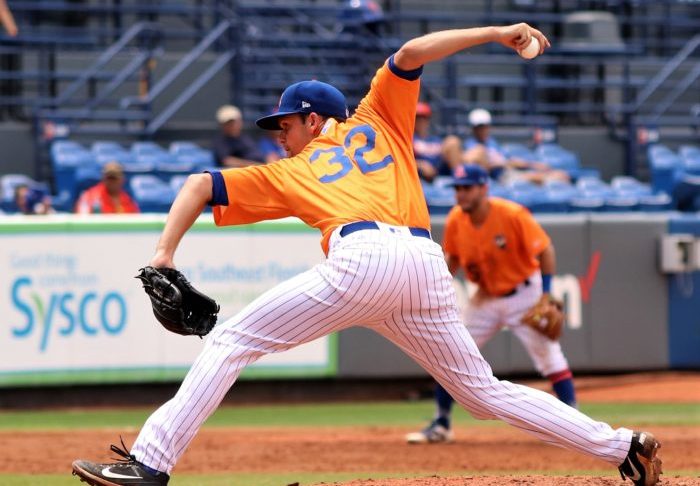Editor’s note: Today we have a special treat for our readers. Many thanks to @reillocity (who previously published on Minor League Ball) for the detailed statistical analysis presented below. — Jacob Resnick
Explanation of FaBIO
The FaBIO (Fielding- and Ballpark-Independent Outcomes) pitcher evaluation system was conjured up circa 2012-2013 in search of a method for evaluating how minor league pitchers were performing on a fundamentally-rooted basis as opposed to traditional hit and run avoidance. Key sabermetric influences include run expectancy tables (Tom Tango) and field-splitting expected-run-avoidance concepts (statcorner.com true ERA).
Every non-bunt plate appearance in a league or conference is sorted into 12 possible outcomes: 1. strikeout (K), 2. walk or hit by pitch (BB/HBP), 3. infield flyball (IFFB), 4. pull-third groundball (Pull GB), 5. center-third GB (Center GB), 6. oppo-third GB (Oppo GB), 7. pull-third line drive (Pull LD), 8. center-third LD (Center LD), 9. oppo-third LD (Oppo GB), 10. pull-third outfield flyball (Pull OFFB), 11. center-third OFFB (Center OFFB), 12. oppo-third OFFB (Oppo OFFB).
For a given league and season each of those events will have a typical run value associated with them; the best for a pitcher are the K, its batted ball cousin the IFFB, and the Pull GB with the K and IFFB worth about -0.3 runs; the worst are the Pull OFFB, Pull & Center LD, & BB rating in the neighborhood of +0.3 to +0.5 runs.
A single “runs per plate appearance” figure is computed for every pitcher in the league; that R/PA value is compared to the mean and standard deviation of either the league’s qualifying sample of starting pitchers (SP) or relief pitchers (RP) to determine how many standard deviations they are above/below average at expected (rather than actual) run avoidance.
Based on that standard deviation relative to league average they are assigned a percentile rating that expresses the expected percentage of league peers (SP or RP) they would beat on expected runs per PA and that percentile rating is what you will see expressed as the FaBIO OVERALL Rating.
As a pitcher analyst, I am not nearly so interested in resolving pitcher performance down to a single number as I am in understanding how that performance value was earned via underlying fundamentals. I use a similar methodology employing K% (K per PA) and BB/HBP% (per PA) to arrive at a K Rating and Control (CTL) Rating. I then omit all BB, HBP, and K events (batted balls only) and redo the Overall Rating to arrive at a BATTED BALL Rating. Reverse engineering Overall Rating reveals that it is typically explained 44% by K Rating, 34% by Batted Ball Rating, and 22% CTL Rating (big takeaway: it is relatively more important to get outs via some combo of the first 2 approaches than it is to avoid BB).
And as with Overall, we can decompose Batted Ball to get percentile ratings for GB, IFFB, LD, OFFB, and Pull OFFB; these batted ball profile sub-ratings provides clues as to the variety and quality of movement within the fastball arsenal and aid in understanding how well a pitcher projects to starting or relieving at the MLB level. FaBIO’s main current limitation is that it does not attempt to adjust for quality of contact, as some LD (GB and OFFB, too) are hit harder than others and not knowing actual exit velocities does not itself preclude attempts to estimate them.
FaBIO Ratings are now available in MiLB and MLB going back to 2013 and in NCAA Division I play since 2015.
Editor’s note (TL;DR): In the images below, green numbers are good. Red numbers are bad.
FaBIO Profiles of Current Mets Pitching Prospects
So let us look at some current Mets pitching prospects and assess what the system suggests about them.
David Peterson
The key FaBIO-centric questions surrounding Peterson heading into 2018 were: 1) could the breakout 2017 K results be sustained, and 2) could he better avoid LD more commensurately with expectations for such a high GB rate pitcher. Pre-2018 Peterson had avoided LD poorer and generated fewer IFFB than a pitcher with his GB should have, indicating that his primary fastball moved down and only down.
2018 Peterson was far better at avoiding LD at both the A and A+ level (perhaps owing to some favorable change in his fastball’s horizontal movement or incorporation of a cutter). Continuation of that trait would increase the likelihood of his Batted Ball Rating playing nearer to his lofty GB Rating.
After a spring training physical issue (Editor’s note: knee), Peterson was conservatively assigned to the South Atlantic League where his K Rating checked in at more than a standard deviation and half below where it had in ’17 NCAA & ’17 MiLB play. By July he had earned a promotion to the Florida State League and the proverbial wheels soon fell off and more so in the CTL/K realm. But almost as swiftly as he had lost his mojo he found it again and was performing as one of MiLB’s best starters over the August to September closing stretch rating nearly plus-plus at all 3 of CTL, K, and BATTED.
Consistency of the offspeed arsenal at inducing whiffs and LD avoidance remain the key developmental areas of focus that will most impact his MLB SP prospects. I would project him as a mid-rotation #3 SP with half plus (70) CTL, average (50) to half minus (30) K, and a plus (84) BATTED. Pushing K ability more into the half plus range and firming up the batted ball profile with beyond plus LD avoidance would push him into #2 SP territory. K rating nearer half minus and a LD-compromised average to half plus BATTED would make him more of a #4 SP option. Working in favor of a MLB SP future is that his two surest strengths, GB first and CTL second, tend not to slump.
Jordan Humphreys
Humphreys rode a power-relievery K/IFFB/OFFB mix during his ’17 South Atlantic League breakout that preceded a very early Florida State League UCL failure. Ideally, his batted ball profile would not skew quite so extreme in the OFFB direction during his ’19 return from Tommy John Surgery. That he formerly posted a very balanced batted ball profile in a very successful ’16 Appalachian League stint makes dilution of the OFFBiness more achievable than it would otherwise be.
Stephen Villines
Villines has consistently dominated left-handed batters since his ’17 senior season at Kansas. Doing so while throwing from a submarine righthanded arm slot is almost unheard of and places him among MiLB’s most valuable relief prospects, where he should be uniquely ranked right alongside a dozen-ish others who feature upper 90s riding four-seamers or wipeout sliders.
Other Mets Pitching Prospects of Note
07-0200 NYM: LHP Kevin Smith (Poll 2)
6’5″ 230-to-200-pounder nearly had triple green A- slashie. With BF/G declining since ’16, sustaining a better slashie over a SP workload will be challenging. SL grades well above 88-92 mph FB & CH, biasing MLB projection in LOOGY direction. pic.twitter.com/qrmJIoZeoY— reillocity (@reillocity) January 31, 2019
05-0140 NYM: RHP Ryley Gilliam (requested by @Jacob_Resnick)
Undersized (5’10”, 175 lb) RHRP rides a plus downer curve off a 92-94 mph fastball to extreme K results. Longer-standing CTL & LD Avoid defects stand to limit MLB RP ceiling & project him as a 7th-inning K specialist. pic.twitter.com/8EsYMXQuyv— reillocity (@reillocity) January 28, 2019










